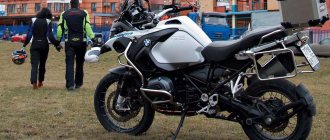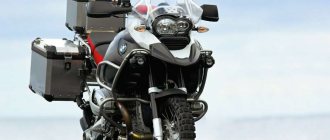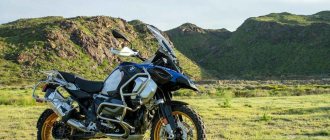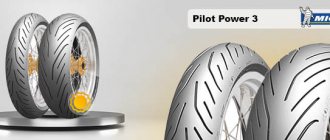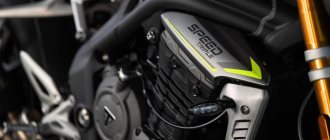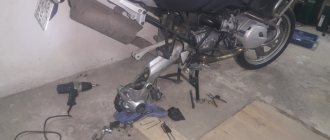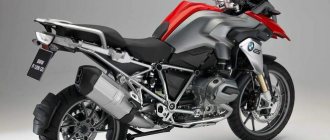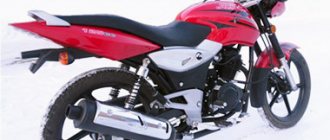Model class : touring enduro
Years of production/sales: 2004-
BMW R1200GS model appeared in March 2004 and became the successor to the BMW R1150GS model. The main changes affected the appearance and technical part:
- New engine : 1170cc, with balancer shaft, 100 (98 for the German market) hp. power and 115 Nm of torque.
- New injection system : BMS-K.
- New design : the design of the plastic, gas tank, and dashboard is changing.
- New ABS system : Since 2006, ABS II with electric booster has been replaced by the more reliable ABS III.
- Reduced curb weight : from 249 to 225 kg.
- New options : electronically adjustable suspension (ESA), stability control (ASC), traction control system - since 2008; LED headlights, keyless entry, quickshifter, security system - from 2014-2016.
In all other respects, the BMW R1200GS model has the classic features of BMW R-series motorcycles: a 2-cylinder boxer engine, proprietary Telelever and Paralever suspensions, cardan drive and ABS. In addition, the BMW R1200GS model has many touring options - heated grips, hand protection, standard saddlebag mounts, cruise control, etc.
Main modifications of the BMW R1200GS:
- BMW R1200GS – regular version. The standard version was sold with alloy wheels (spoke wheels are available as an option).
- BMW R1200GS Adventure – top version. Available since 2005. It features spoked wheels in the base, longer travel suspensions, a 33-liter fuel tank, as well as a windshield, protective linings on the cylinders, arches and plastic aerodynamic elements.
Main generations of BMW R1200GS:
- BMW R1200GS (2004-2007) – first generation. Models of these years produce from 98 (for the German market) to 100 hp. power and 115 Nm of torque.
- BMW R1200GS (2008-2009) – second generation. The compression ratio increases to 12.0:1, maximum power increases to 105 hp, versions with ABS II lose the electric brake booster. New options appear: ESA (electronic suspension adjustment) and ASC (traction control). The model is undergoing a slight restyling, changing the shape of the plastic on the tank, the design of the rims and some other visual elements.
- BMW R1200GS (2010-2012) – third generation. The engine receives a new cylinder head with two camshafts (DOHC), which increases the maximum speed to 8500 rpm and the maximum power to 110 hp. at 7750 rpm.
- BMW R1200GS (2013-) – fourth generation. The model receives a new liquid-cooled engine with 125 hp. power and 125 Nm of torque; updated appearance (small cosmetic differences, cantilever swingarm with cardan on the left side); new brakes with a larger diameter rear disc and radial mounted front calipers; increased tire size; new clutch (multi-disc slipper in an oil bath); curb weight increased by 9 kg; electronic throttle with 5 traction control modes; new generation Paralever rear suspension – EVO (swingarm length and ground clearance increased); non-adjustable hydraulic steering damper in stock. New electronic options - quick shifter, LED headlights, Keyless Ride, Dynamic ESA semi-active suspension, tire pressure monitoring system.
The current BMW R1200GS is BMW's flagship touring enduro, gaining popularity around the world. The model was repeatedly recognized as the motorcycle of the year and was the best-selling model in Europe and various countries.
In 2012, Cycle World magazine named the BMW R1200GS the "Most Successful Motorcycle of the Last 25 Years."
Brief history of the model
- 2004 – start of production and sales of the BMW R1200GS.
- late 2005 – early 2006 – start of production and sales of the BMW R1200GS Adventure.
- 2006 – appearance of modifications of the BMW R1200GS with ABS III.
- 2008 – second generation. On the regular version, the design of the plastic on the tank and the rims (in versions with cast aluminum wheels) change. On versions with ABS II, the electric brake booster is removed. Maximum engine power increases to 105 hp. by increasing the engine compression ratio (from 11.0 to 12.0). New electronic options appear - ESA, ASC.
- 2010 – third generation. The main difference was the use of new cylinder head with two camshafts (DOHC). Maximum power increases to 110 hp.
- 2013 – fourth generation. The BMW R1200GS gets a new liquid-fuel engine, styling changes, new brakes, clutch and a host of new electronic options. The turn signals now have one switch on the left remote control (instead of the traditional BMW two, on the corresponding remote controls). The Adventure version has a 30-liter aluminum fuel tank.
- 2014-2016 – additional options: LED headlights, keyless entry system, quick shifter. The ABS system receives new firmware, increasing the safety and adequacy of the system's response when cornering.
- 2017 – this year’s models received adaptive headlights and a damper on the gearbox output shaft (as on the Adventure version). The gearbox units have also been modified and improved. Standard GS models now have the same roll bars as the Adventure version.
Specifications
Technical characteristics of BMW R1200GS:
| Model | BMW R1200GS |
| Motorcycle type | touring enduro |
| Year of issue | 2004- |
| Frame | composite, two-section, engine - load-bearing element |
| engine's type | 2-cylinder 4-stroke boxer (Boxer) |
| Working volume | 1170 cc |
| Bore x Stroke | 101x73 mm |
| Compression ratio | 11.0:1 (since 2008 - 12.0; since 2013 - 12.5:1) |
| Cooling | air-oil (since 2013 - air-liquid) |
| Number of valves | 4 valves per cylinder, 1 camshaft per cylinder head (DOHC - since 2010) |
| Fuel supply system | injector BMS-K+ |
| Ignition type | electronic |
| Maximum power | 100 hp at 7000 rpm (105 hp - 2008-2009; 110 hp - 2010-2012; 125 hp - since 2013) |
| Maximum torque | 115 Nm at 5500 rpm (120 Nm - 2010-2012; 125 Nm - since 2013) |
| Transmission | 6-speed |
| type of drive | cardan |
| Front tire size | 110/80 ZR19 (from 2013 - 120/70 R 19) |
| Rear tire size | 150/70 R17 (2013 - 170/60 R 17) |
| Front brakes | 2 discs, 305 mm, 4-piston calipers, semi-integral ABS II (ABS III - since 2006; radial calipers - since 2013) |
| Rear brakes | 1 disc, 265 mm, 2-piston caliper, semi-integral ABS II (ABS III - from 2006, 276 mm - from 2013) |
| Front suspension | BMW Telelever (preload adjustment), stroke - 190 mm (Adventure - 210 mm) |
| Rear suspension | pendulum BMW Paralever (compression and rebound adjustment, optional ESA), stroke - 200 mm (Adventure - 220 mm) |
| Overall dimensions (LxWxH) | 2210x915x1430 mm (Adventure - 2250 x 955 x 1470 mm) from 2013 - 2210x953x1450 mm (Adventure - 2255x980x1450 mm) |
| Seat height | 840/860 mm (Adventure - 890/910 mm) from 2013 - 850/870 mm (Adventure - 890/910 mm) |
| Gas tank capacity | 20 l (Adventure - 33 l) from 2013 - Adventure - 30 l |
| Maximum speed | 208 km/h |
| Acceleration to 100 km/h (0-100) | 3.4 sec |
| Motorcycle weight (curb) | 225 kg (Adventure - 256 kg) since 2013 - 238 kg (Adventure - 260 kg) |
Testing BMW R1200GS and R1200GS Adventure 2008
A good motorcycle is like a good suit - it should be comfortable and fit the owner well. I have to say that this GS bike is almost perfect for me, it looks quite decent on high quality highways and doesn't mind running around on dirt roads.
I rode the first of these "dual-purpose" BMW models, the R80G/S, along the bottom of Copper Canyon in Mexico back in November 1980, and thought it was one damn good bike. “What a wonderful car! “I thought then, “this motorcycle can comfortably travel hundreds of miles on paved roads, and then hundreds of miles on dirt roads.”
Now, 28 years later, I can say that the 2008 R1200GS , the fifth generation of the model, is even better. Don't get me wrong, he's not perfect. BMW offers many other models. And if I needed to go really fast, I'd take the HP2 Sport, or the K model, and for rough-road driving they have the G650 Xchallenge, with 50 horsepower and weighing only 350 pounds. This same GS model, with a full tank of fuel (5.3 gallons - 2-0 liters) and without luggage, weighs 541 pounds (245 kg). But let's get back to the new GS. This is the fifth year of the 1200 cc variant, and the guys from the secret workshops in Munich seem to be listening to customer wishes. Riders complained that the GS became sluggish as engine displacement increased from 800cc to 1,150cc, and when engineers developed the 120cc engine five years ago, they put the bike on a strict diet and it lost nearly 66 pounds (30 kg). Last year they ditched that stupid servo engine braking system that no one seemed to like... at least no one I talked to.
The GS fits me perfectly without overpowering my 195cm height, and it's fast enough to keep most riders happy.
Before I get into the specific details of the bike, let me talk about its presentation. Eighteen motorcycle journalists flew to Phoenix, Arizona, in early spring to spend two days on motorcycles and three evenings in bars, eating too much food and drinking. The fact that these guys were pleased with the presentation has little to do with white wine and baked fish. It was necessary to provide good trails for driving. Boring roads take their toll on any motorcycle, but BMW offered some of the best dirt roads I've been on in years. We were divided into two groups, and my group had to use the GS Adventure , and switch to the standard GS on the second day. And on the first day it was quite a ride, 27 miles (43 km) of rough road through an area called the Four Peaks in Tonto National Park. Amethysts have been mined here for years, and whoever laid forest road No. 143 here later had a peculiar sense of humor. Our GS Adventures had tires with much-needed deep tread, as probably did the forest service, which is responsible for maintaining this delightfully uneven section between rocks and cacti. Someone decided to treat it with a grader, which led to an accumulation of soft, unpacked soil on the uphill turns. We wisely stopped at the start of the road and turned off the ABS and ASC (automatic stability control - road traction control system). The trip wasn't very difficult and was a lot of fun, but that's what the Adventure model was made for.
The GS has good, easy to read instruments and the computer provides a lot of information that is visible even on a bright sunny day.
As for ASC, this system actually turns off the engine when the rear wheel begins to spin faster than the front. On the drive home, I enjoyed the GS's performance on a dirt road with ASC engaged, shutting down the engine. Admittedly, this system is not the sort of device that a motorcyclist with my limited experience would use on a dry paved road. Of course, I could over-accelerate in the wet and this system would save me from falling over, and since it was connected to the ABS, I would have been glad to have it. Note: If someone wants to impress onlookers with a sudden rear wheel lift, be sure to turn off the ABS/ASC first, otherwise the ASC will intervene as the front wheel lifts and slows down the rotation. The next day I was on a GS with spoked wheels. The new GS standard is essentially a street bike, with little claim that it will perform well on dirt roads (if any), and the smarter guys at their BMW/NA realized that our road was too difficult for the standard wheels made of magnesium, here the advantage was given by the flexibility of the spokes. We followed the old road to the Bradshaw Mountains and the old mining town of Crown King. I've seen this place on the map for years, but I've never had either the right type of bike or the free time to get here. This is a mountain road, and I managed to hit a sharp stone with my front wheel, which punched a small hole in the overflow pipe. Nothing major, but one of our guides swapped bikes with me during lunch. The base plate needs to be slightly larger to protect the main tubes.
This beak-shaped wing is oil-cooled, provides good airflow and is protected from rocks.
After our afternoon snack we headed east and crossed the Aqua Fria River valley and the national monument of the same name. We drove through an amazing place called the Bloody Pool, which was 50 miles (80 km) of dirt road stretching out in front of us. This road is crossed by many old riverbeds, most of which have already dried up. The suspension had to work hard in these channels, about a foot wide (31 cm), which tucked imperceptibly under the wheels. As we crossed the New River Mountains, we were rewarded with stunning views that made us stop to admire the scenery at almost every turn. After that, we returned to our accommodation to get ourselves in proper shape before the farewell dinner. Most of the group was flying out the next morning, but I asked to be allowed to make one more trip, planning to return the next morning. I drove about 50 miles (80 km) on the interstate and the GS was perfectly happy to stay in the lane at speeds exceeding 85 mph (137 km/h), and its small windshield did a great job of keeping wind. I then turned northwest toward Parker and then crossed the Colorado River into California. CA 62 is an unexciting two-lane highway through the Mojave Desert, and I headed to Joshua Tree National Park, three-quarters of a million acres of beautiful desert scenery. I thought about driving through the old Gold Crown Road, but it was getting close to the end of the day and I still needed to take some photos. So I entered the park through the town of 29 Palms, making a shorter loop through Bighorn Pass, and got out onto a decent dirt road. GS was in his element. I spent the night in the small town of Joshua Tree, a mile-wide community on Highway 62, and studied the map in front of my cup of coffee at dawn. I decided to stay on the north side of the San Gabriel Mountains - which turned out to be a very windy route that had the wind blowing at me the entire 180 miles (290 km) of the way to Tijdon Pass... where it suddenly died down. The GS handled the tricky weather quite well, even with the big boxes in the back. By the way, each of these side bags weighs 13 pounds (6 kg)... empty.
The GS dual purpose touring bike gets a 9 in my notebook - it handles very well on the highway.
From Tijon I continued west along the San Emigdio Mountains, past Pine Mountain, and soon the Andreas Fault appeared in front of me, which eventually led me to Carrizo Plain National Monument. In spring it is a stunning place, with its poppies and lupins in bloom. After a leisurely drive across a flower-covered plain, I found myself just 50 miles (80 km) from home. And I can't remember a more enjoyable trip, with a small freeway, lots of secondary roads, and hundreds of miles of dirt roads. The GS handled this trip in a commendable manner. The GS motorcycle remains one of BMW's best-selling motorcycles, and to maintain interest in the market, major changes are made every few years, with smaller updates in between. And this 2008 model showed some minor modifications. To enhance the “masculine body language,” as the manufacturer’s press service puts it, the appearance was slightly changed, the front fender became more convex on top, stainless steel reflectors appeared in front of the fuel tank, and the sliding tubes of the front suspension and cylinder heads are now painted in magnesium color . I think the GS has a great look - it's always been very masculine, nothing slender or graceful, just purposeful. Translated into anthropomorphic language, this is the type of guy I would want to have next to me during an argument in a bar, or in a foxhole.
Parameters of 2008 BMW R1200GS. (green line - horsepower, blue - torque, horizontal axis - revolutions per minute)
Engineers tinkered with the size of the valves, camshaft and more, giving the bike more muscle. It's said to have a 5% increase in power over last year's model - not as much as the HP2, of course, but it's officially rated at 105 horsepower at the crankshaft at 7,500 rpm (96 horsepower at the rear wheel). , this is something to write home about. The engine is very smooth, the power delivery is linear, and the GS can perform well in acceleration races, lifting the front wheel painlessly. The compression ratio is 12.0:1, which means that high-quality gasoline is recommended, but fuel consumption remains quite acceptable at 37.7 mpg (6.2 liters per 100 km). In addition, the motorcycle is equipped with a fuel knock sensor, so that lower categories of gasoline can be used. Fuel injection has been improved to meet environmental concerns, and on a cold day when the temperature rises just above the freezing point of water, the bike starts easily but takes half a minute to warm up before increasing the fuel supply. In terms of ergonomics, the driver can now turn the steering wheel 90 degrees to improve driving while standing. Since I usually drive sitting, I leave the steering wheel in the lowest position. It's nice, the wide bar ends are 35″ (890mm) apart, and it's very comfortable for those who want to ride in first gear. The GS's footpegs are a little small, although the Adventure's are larger and more comfortable to stand on. I think both motorcycles should have footpegs like this. The six-speed transmission has been slightly reworked, with different ratios for improved performance on paved and unpaved roads. And speed switching has become more precise. Boxer transmissions have always felt a little clunky to me, but that's part of the "character" of the car. The bike has a round tube trellis frame with telelever suspension at the front and paralever at the rear which works very well. For the 2008 GS (non-Adventure) model, the front end has been slightly adjusted, the steering column rake has been reduced from 27.1 to 25.7 degrees, with a concomitant reduction in trail from 4.3″ to 4.0″ (from 109 to 102 mm), and the wheelbase has been shortened by 1/2 5″, and is now 59.3″ (1506 mm). It's all about these busy, winding cobbled roads.
2008 BMW R1200GS
Riders with short legs will have to learn to get their leg over the saddle at 33.5″ (851mm), but this is a matter of practice. The center support deserves special mention as it pivots very precisely and is easy to use even when the trunk is fully loaded. The real highlight of the chassis is the electronically controlled suspension system, called Enduro ESA. I can't tell you how much I love this element of sophisticated automation. But there is something about it that gives great pleasure when driving when the road changes, becomes twisty, abnormal. And the COMF mode you set for the suspensions can be changed - touch the button and your bike goes into NORM mode, touch again and you're in SPORT mode. In years past, you'd have to stop, pull out a couple of tools, and change the settings... or, most likely, not do it at all. But now everything has changed! You can change damper adjustments on the fly, with three spring preload options (rider, rider and luggage, rider and passenger) when the bike is in neutral with the engine running. This is correct because you should set the tension before you hit the road. On the GS, BMW added an off-road mode that allows the spring tension to be set to medium (50%) or maximum (100%) and then increased the road clearance by another inch (20 mm). The damper setting modes are called SOFT, NORM, HARD (soft, medium, hard) and are accompanied by an image of low hills indicating the average spring tension, or high mountains indicating the maximum tension. A number of agreements in these modes should please any motorcyclist. Everything is done through the wizardry of micromotors and electro-hydraulics, and you can clearly feel how changing the shock spring preload lifts or lowers the bike. The suspension has decent travel - 7.5″ (191 mm) on the front wheel, and 7.9″ (200 mm) on the rear. I would say that where I intend to seriously drive this car, such as on the train from here to Tierra del Fuego, I would probably prefer traditional shock absorbers... to make fewer mistakes. But since I mostly ride in North America, the Enduro ESA definitely ends up on the list of options to have. But all this does not come for free. The base R1200GS retails for $14,600, which seems reasonable. As I said before, spoked wheels are an optional extra on the GS...for $495. My bike had the Safety Package, which included in-dash tire pressure monitors and ABS/ASC, which added $1,650 to the price. Add in the Equipment Package 2, which includes the amazing Enduro ESA, heated grips, and a bunch of other goodies, and it adds another $1,495. Plus $1,000 for the luggage bags, and $3,000 for the rear rack... and with taxes, fees, etc. it's over 20 grand. Great bike. I really liked it and wouldn't mind having it in my garage. Maybe you should stop by 7-Eleven and buy a lottery ticket.
The Adventure is a macho version of the GS motorcycle, featuring deep tread tires and skid plates.
BMW R1200GS Adventure
The GS Adventure comes with a price tag of $16,600—so what are you paying a couple thousand extra for? A more masculine appearance, of course. He just oozes Rambo. The Adventure has a larger fuel tank of 8.7 gallons (33 L), which is good for crossing the Sahara as it provides a range of over 300 miles (483 km). It also has larger windshield sizes. And wider footrests, which are comfortable to ride while standing. The gear shift lever and foot brake are easily adjustable. Spoked wheels and deep tread tires are standard. It is also more secure, being equipped with protective frames covering the fuel tank and cylinders. The front guard protects the cylinder heads. Hand protection is also included as standard. It has the same powertrain as the standard GS , but the chassis is slightly different. The head angle and trail are similar to last year's model, with a 59.5″ (1511 mm) wheelbase, but the shocks have an extra 20 mm of travel. The standard seat height is 35.2″ (894 mm), which forces even long-legged riders to use the left footrest as support when mounting the motorcycle. The front suspension travel is 8.3″ (211 mm). The rear suspension has 8.7″ (221 mm) travel. In addition, a huge number of options and accessories are available. The side luggage bags and rear rack are rectangular aluminum containers that have a nice, solid, ready-to-wear appearance. ABS/ACS, Enduro ESA, and everything else are added at extra cost. As one BMW loyalist said, you get what you pay for. And you definitely get a cool image when you drive your Adventure to the nearest cafe in the morning for a cup of coffee. Just remember that every additional liter of fuel and every accessory reduces the bike's carrying capacity - which is the same as a standard GS.
